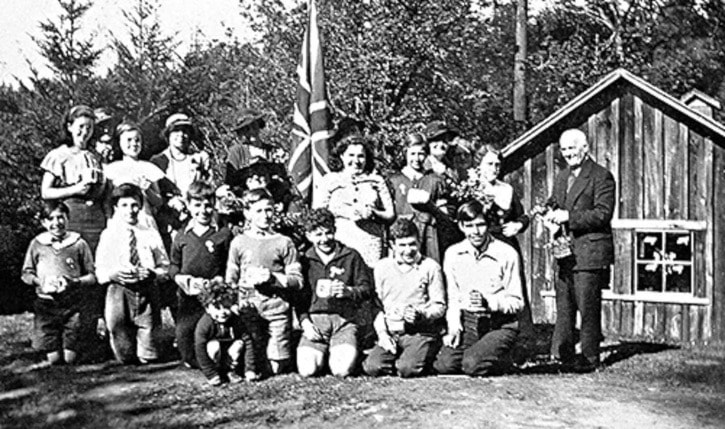This 1937 photo shows the second of three locations that accommodated East Sooke schools. Half a century after this, Bryan Mooney was operating a fish processing plant almost exactly on the same spot as this school, on East Sooke Road, a bit west of Ragley.
The teacher in this photo is Mrs. Winnifred Mugford, who was married to Bert Mugford of Sooke, a longtime wireless operator on the Coast Guard’s Estevan. We believe the officiating gentleman is an Inspector of Schools called Mr. Gamble, who appears to be handing out awards at an annual school celebration event.
The Union Jack is prominent in this scene, standing alongside the board and batten school building. An earlier one room school, established in 1888 stood near Seagirt and operated with a series of teachers until a shortage of students closed it down.
In 1921 this school was built on an acreage leased from Lady Emily Walker and was operated until 1946. The Cameron Report on education in that year meant a number of changes were ahead for area schools, with consolidation into central larger schools, including the opening of Milne’s Landing High school.
Youngsters in this photo include Doris, Herbie, Arthur and Kathleen Caffery, and John and Amy Kennedy. Also seen are Kathleen and Gerry Wilson, George Forrest, John Pegg and Joan Eminson. While Vern and Louise Wright (now Paterson) also attended this school, they aren’t in the photo. We’re told that the students, boys and girls, carried out the janitorial duties.
The tousle-haired little pre-schooler crouched at left front is Kay Caffery, a grand daughter of East Sooke’s famous Lady Emily Walker. Many of us knew her well in recent years as Kay Jeffrey.
The final East Sooke School, to accommodate elementary pupils was built near Anderson Cove (Caffery Bay to us oldtimers) in 1946 and remained open until 1949, when students were transported over to Sooke. While each was a one-room school, the third was quite a bit fancier, with lots of windows.
It wasn’t until the 1970s that the population of East Sooke began to see enormous expansion.
Elida Peers,
Historian
Sooke Region Museum
